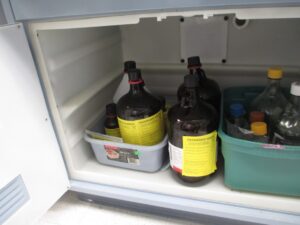Federal regulations of the U.S. Environmental Protection Agency (USEPA) require a small quantity generator of hazardous waste (SQG) to maintain equipment and processes to prevent a hazardous waste emergency and to respond to it if one occurs. The regulations are found in the following SQG conditions for exemption:
- 40 CFR 262.16(b)(8) Preparedness and prevention
- 40 CFR 262.16(b)(9) Emergency procedures
This article is the eighth in a series that closely examines and explains these regulations.
In the previous article in this series I addressed the requirements of 40 CFR 262.16(b)(9)(i) Emergency Coordinator for a Small Quantity Generator. That was the first of the Emergency Procedures requirements of §262.16(b)(9). This article is the second of those regulations.
The purpose of this article is to identify and explain: 40 CFR 262.16(b)(9)(ii) Post emergency information at small quantity generator of hazardous waste.
Before we begin…
These regulations were revised by the Generator Improvements Rule. If your state has not yet adopted the new rule you must continue to comply with the earlier version until it does. You may read an article explaining the earlier version of the regulations (prior to implementation of the Generator Improvements Rule) here.
After your state adopts the Generator Improvements Rule, it may choose to make its version of these regulations more stringent and more broad than these Federal regulations. The actions of your state will vary based on whether or not it has an authorized hazardous waste program. Be sure to check the regulations of your state to ensure compliance.
Scope and applicability:
The regulations addressed in this article are applicable to a SQG. There is no equivalent for a large quantity generator of hazardous waste (LQG). A LQG, instead of merely posting information near a telephone, must have a Contingency Plan. You can read about the responsibilities of a LQG here: Preparedness, Prevention, and Emergency Response Procedures for a Large Quantity Generator of Hazardous Waste.
Not sure of your hazardous waste generator category? |
The placement of these regulations squarely within 40 CFR 262.16 Conditions for exemption for a small quantity generator that accumulates hazardous waste removes any doubt that these regulations apply solely to a SQG.
 But where at a SQG? The entire facility? And what operations? Just those related to hazardous waste management? In the preamble to the final rule in the Federal Register, USEPA stated its primary objective was to ensure these regulations do not apply to the entire facility (November 28, 2016, FR 81, 85792). However, USEPA did clarify that these regulations – and all preparedness, prevention, and emergency response procedures of both SQG and LQG – are applicable to all areas of a facility where hazardous waste is:
But where at a SQG? The entire facility? And what operations? Just those related to hazardous waste management? In the preamble to the final rule in the Federal Register, USEPA stated its primary objective was to ensure these regulations do not apply to the entire facility (November 28, 2016, FR 81, 85792). However, USEPA did clarify that these regulations – and all preparedness, prevention, and emergency response procedures of both SQG and LQG – are applicable to all areas of a facility where hazardous waste is:
- Generated. This means all points of generation.
- Accumulated. This includes both central accumulation area(s) (CAA) and satellite accumulation area(s) (SAA).
- Those areas where allowable treatment of hazardous waste may occur in accumulation units (November 28, 2016, FR 81, 85792).
All satellite accumulation areas operated by a small quantity generator must meet the preparedness and prevention regulations of §262.16(b)(8) and emergency procedures of §262.16(b)(9). Prior to the Generator Improvements Rule agency guidance and enforcement limited the applicability of these regulations solely to hazardous waste in the CAA and did not include the SAA. To clarify its position in the preamble, USEPA also added the following to the revised regulations for SAAs at §262.15(a)(7):
All satellite accumulation areas operated by a small quantity generator must meet the preparedness and prevention regulations of §262.16(b)(8) and emergency procedures of §262.16(b)(9).
This is further reinforced by the opening paragraph of §262.16(b)(9), which reads:
The small quantity generator complies with the following conditions for those areas of the generator facility where hazardous waste is generated and accumulated:
Like this article? Subscribe to my Monthly Newsletter No marketing emails! |
Believe it or not, we’re still not done with the Scope and Applicability of these regulations because USEPA thought it necessary to modify these regulations from the original to clarify where exactly this information must be posted. That will be addressed later in this article.
40 CFR 262.16(b)(9)(ii) reads:
(ii) The small quantity generator must post the following information next to telephones or in areas directly involved in the generation and accumulation of hazardous waste:
(A) The name and emergency telephone number of the emergency coordinator;
(B) Location of fire extinguishers and spill control material, and, if present, fire alarm; and
(C) The telephone number of the fire department, unless the facility has a direct alarm.
Why the change?
USEPA felt that existing regulations were unclear where the required information should be posted in the facility. From USEPA: “A facility may have many operations and components that have no relationship with the generation and accumulation of hazardous waste.”

Also, the new rule clarifies that an “emergency” telephone number must be provided for the emergency coordinator.
Interested in site specific training at your site that covers this topic, and more! Ask me about my Onsite Training |
What’s the Point?
The point of this regulation is for the employees of a SQG – both hazardous waste personnel and other workers – to have access to information they may need in an emergency. Since a SQG is not required to have a Contingency Plan as is the LQG, information must be made available where it will be needed.
Q: But honestly! Why post information near a telephone when everyone has a cell phone and we live in an age of near-universal 911 availability? And, if required, why not post the information in a worker break area? Why not eliminate this requirement entirely?
A: USEPA considered comments just like those in its proposal for this rule. USEPA disagreed with eliminating this provision since making such information readily available is important for workers and others so that they know what to do and where to go in the event of a hazardous waste emergency.
“…must post the following information…”
Some commenters to the proposed rule requested the option to maintain the required information on cell phones. While USEPA did not forbid storage of information on cell phones, it did not change its requirement to post the information where specified. By “post” USEPA means a physical post; a document displaying the required information visible in the event of an emergency. It may be that employees of your facility are trained to know this information by heart or perhaps carry it with them on a small card. Both of those are good ideas, but they do not take the place of the requirement to post the required information in the areas specified.
Contact me with any questions you may have about the generation, identification, management, and disposal of hazardous waste Daniels Training Services, Inc. 815.821.1550 |
“…Next to telephones or in areas directly involved…”
This is one of the big changes to this regulation for SQGs. Prior to the Generator Improvements Rule, this regulation required the SQG only to post the information, “next to the telephone.” In order to clarify the areas of the facility where the required information must be posted, the new regulation provides two options. The required information must be posted in one of these two areas:
- Next to telephones.
Or…
- In areas directly involved in the generation and accumulation of hazardous waste.
Now, “next to telephones” could mean every single phone in your facility. Or, it could be interpreted to mean just those that may be used in an emergency; that still may be a lot. It’s the second option added by the Generator Improvements Rule that more specifically states the areas where this information must be posted. And note, the second option doesn’t specify it be near a telephone (perhaps there aren’t any telephones in these areas), only that if be in those areas directly involved in the generation (point of generation) and accumulation (CAA and SAA) of hazardous waste at a SQG.
Q: So, I don’t have to post my emergency response information near a telephone?
A: Nope. Not as long as it complies with the second option and is an an area directly involved in the generation and accumulation of hazardous waste.
The required information:
Only one word was added to the last three paragraphs of this regulation listing the information required to be posted. One word, but great significance. The following information is required:
- The name and emergency telephone number of the emergency coordinator.
- Location of fire extinguishers and spill control material, and, if present, fire alarm.
- The telephone number of the fire department, unless the facility has a direct alarm.
There was no change to the requirements of the last two bullet points. However, in the first bullet point the word “emergency” was added before “telephone number”, representing a significant change. The regulation now allows for the posting of any number – home, mobile, work – that can be used to reach the emergency coordinator in an emergency. USEPA felt the regulations prior to this change were unclear whether the telephone number for the emergency coordinator referred to a home or business phone.
Several commenters cautioned – and USEPA agreed – that cell phone reliability could be compromised during a widespread emergency.
Contact me the next time hazardous waste generator training is due to expire. |
I’ve created a document you can use to fulfill these regulations: Small Quantity Generator Emergency Posting
Let me know if I can make any modifications to it in order to better suit your operations.
A quick Summary:
- Required information must be posted next to telephones or in areas directly involved in the generation and accumulation of hazardous waste.
- The telephone number provided for the emergency coordinator must be one that can reach that person in an emergency.
Is that it?
 No. First of all, as a SQG you must still comply with the remaining requirements of §262.16(b)(9) for emergency procedures and there remains the preparedness and prevention regulations of §262.16(b)(8). You may view all of those regulations here.
No. First of all, as a SQG you must still comply with the remaining requirements of §262.16(b)(9) for emergency procedures and there remains the preparedness and prevention regulations of §262.16(b)(8). You may view all of those regulations here.
The next article in this series will address 40 CFR 262.16(b)(9)(iii). It mandates the SQG ensure that all employees are thoroughly familiar with proper waste handling and emergency procedures. The regulations don’t call it “training”, but it sure sounds to me like some form of instruction or information must be presented to hazardous waste personnel of a SQG; I call that training.
